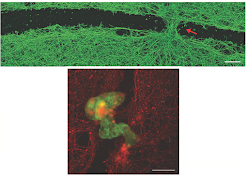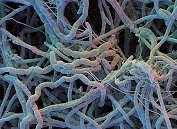Charles Richard Drew: “Father of the Blood Bank”
Link to article
(Click images to enlarge.)
People don't often give a second thought to the process of donating blood or receiving it when needed. It's just always there in supply for routine and life-saving operations. But the history of blood transfusions and the nature of blood is a long one. And only 80 years ago did Dr. Charles Drew come up with a critical step in the storage of blood which has saved many lives.
From Wikipedia
William Harvey, an English doctor, discovered the circulatory system and published on it in 1628. Back then, the color of blood had been thought to indicate whether it was providing mere nutrients (purple blood) or some unique "vital factor", a life-giving principle from the lungs (red blood). Thirty years later, the Dutch scientist Jan Swammerdam looked at blood under a microscope and observed red blood cells for the first time. Nobody saw anything else until 1843, when Gabriel Andral, a French professor of medicine, and William Addison, an English doctor, separately noticed white blood cells. A year earlier, French physician Alfred Donné discovered platelets in blood, tinier than either red or white blood cells. These three made up the three solid components of blood as we know it today. The liquid part that carries these cells is called plasma.

Charles Richard Drew was a Black American born on June 3, 1904 in Washington, D.C. It should be noted that he grew up in an interracial neighborhood in a middle-class family. At Dunbar High School, known as one of the best college prep schools in the country for blacks or whites, Drew was active in sports and earned letters in four of them. He joined the High School Cadet Corps there and became a captain. His goal at the time was not medicine but electrical engineering.
Drew's high school picture and description (Wikipedia) He became interested in medicine at Amherst University, though, and graduated there in 1926. Drew decided to go teach biology and chemistry and be the football coach at Morgan University in Baltimore, Maryland for two years. That supplied him with enough money to attend medical school. For various reasons, he went to McGill University in Montreal instead of American schools. In 1933, he graduated second in his class while still playing sports there. As a resident then intern in 1933-1935 at Montréal General Hospital, Drew worked with bacteriology professor John Beattie, who studied exploring ways to treat shock with blood transfusions and other fluid replacement.
Because places like the Mayo Clinic were not widely accepting Black physicians, he chose to work at Howard University College of Medicine (an all-Black institution) in Washington, DC in 1935. He was initially a pathology instructor, and then became a surgical instructor, and finally the chief surgical resident at its affiliated Freedmen's Hospital. The hospital was founded in 1862 and was known to be the first hospital to provide medical treatment to former slaves.
From there, he gained surgical experience and moved to New York's Presbyterian Hospital, while simultaneously attending Columbia University beginning in 1938 for a doctorate in medical science. He was the first African American to earn such a degree there. At the hospital, he continued his interest in shock and transfusions.
A short history is needed on transfusions in order to understand Drew's research and his later work.
- 1665 The first recorded successful blood transfusion (England). Dogs to dogs.
- 1667 More work on sheep, cows, dogs, horses, and goats. First transfusions from sheep to humans by Jean-Baptiste Denys (Denis). Because the lamb was a symbol of Jesus Christ and therefore would contain the purest blood, this was the reason it was chosen for humans. Initially a success, the patient then died, and a court case cleared Denys, but French and English governments put severe restrictions on transfusions after that for 150 years.
- 1818 First successful transfusion of human blood (350 cc) by James Blundell to a patient.
- 1873-1884 Americans attempt transfusing milk from cows, goats, and humans. Then they tried salt water (saline).
- 1900-1905 Stitching together blood vessels for direct transfusions was perfected.

- 1901 Austrian Karl Landsteiner discovers the first three human blood groups (A, B, O). Six years later, Ludvig Hektoen suggests that cross-matching blood between donors and patients would be safer, and Reuben Ottenberg and Albert Epstein perform the first blood transfusion using blood typing and cross-matching. Most physicians still thought that typing was not needed.
- 1914 First indirect transfer of blood in a transfusion by Albert Hustin. Before this, patients and donors were connected directly. Indirect transfer means collecting the blood first into a container, then giving it to the patient.
Direct (left) and indirect (right) transfusion methods (indirect keeps blood warm in water bath)
- 1915, 1916 Richard Weil and later Francis Rous and J.R.Turner add citrate or citrate-glucose to permits storage of blood for several days after collection.
- 1932 First blood bank established (Leningrad) and in 1937 (Chicago)
- 1936 John Elliot designed the first vacuum bottle for collecting blood
- 1939-1940 The Rh blood factor is discovered (you are either positive or negative).
- 1940 Edwin Cohn developed a procedure to separate albumin, gamma globulin, and fibrinogen components from plasma.
Back to Charles Drew, with his newly minted doctoral degree awarded in 1940: "Banked Blood: A Study on Blood Preservation". What was it all about? Clearly, he had a lot of medical discoveries in recent years to fall back on.
Drew's dissertation mentions research from others in the 1920s suggesting how long blood could be kept under certain conditions that stabilized it (or "conserved" it). Those terms mean simply that care must be taken to ensure that during storage the red and white blood cells don't degenerate and that the blood doesn't clot. To quote from his dissertation:
p. 88 of Drew's dissertation
He looked into research on changes in blood's biochemistry and cell shape as well as immune properties, and he further spent 100 pages describing studies on preservation of blood, whether from placentas, cadavers, the aged, or freshly dead people. The blood chemistry changes during storage were explained in terms of illnesses that might benefit from transfusions. He even described the shape of containers and how they benefitted lengthy storage:
p. 198 of Drew's dissertation
He noted that the condition of blood was good up to 15 days at 3-5ºC (37-41ºF), compared to only 3 days at body temperature. Drew added that not only should blood be stored at that temperature, but that it should be chilled immediately after it was donated and kept "free from mechanical shaking or movement" to reduce the risk of cellular damage. Ultimately, he determined that blood kept for 10 days under the physical and chemical conditions he outlined was as healthy as freshly drawn blood.
The final chapter in his dissertation described his proposal to establish a blood bank at his hospital. Survey results from four other hospitals in the U.S. (including Chicago) were used to incorporate valuable data in the creation of his own blood bank facility. His proposal was accepted. The result was a set of policies on administration, staff, blood drawing conditions of the hospital and patient, and sanitary conditions, and by the time he finished his dissertation, he had collected statistics (including health at blood drawing time and afterward) on the first 400 donors from August 9, 1939 to February 23, 1940!
Charles Drew, early 1940s
As mentioned already, blood is composed of liquid (plasma) with vital protein chemicals as well as the solid components of red and white cells and platelets. If they are together, it is called whole blood. Plasma was deemed more valuable than whole blood during wartime in many instances. Its loss from the body lowered blood pressure, and it was more important to restore that for the patient's stability than to provide red blood cells to boost oxygen-carrying capacity. Frozen plasma took 20 minutes to thaw, though, and it required special storage units. Freeze-dried plasma was more convenient in terms of storage and simply had to be reconstituted with sterile water before use.

America was approached by Britain in World War II to help provide blood plasma for the expected casualties. In June 1940, Dr. Charles Drew was called upon to head up an effort to provide liquid plasma for British soldiers in the "Blood for Britain" campaign. With his guidance, the program scaled up his own hospital system to collect, process, and store plasma at nine hospitals. The first shipment went out in August. By the end in January 1941, Blood for Britain had collected 14,556 blood donations, and shipped over 5,000 liters of plasma with help from the American Red Cross. Drew was now considered the expert on blood donations and processing.
From February to April 1941, Drew worked again with the Red Cross to initiate a dried plasma program this time, which later became the National Blood Donor Service.
It was Drew who introduced mobile collection units (later called "bloodmobiles.")

Despite his fame and success in assembling medical teams, the National Blood Donor Service became a sore point for Charles Drew. At the insistence of the Armed Forces, Blacks were not allowed to donate blood, and in retaliation, black news agents and the National Association for the Advancement of Colored People (NAACP) voiced their protests. A year later in 1942, the Red Cross changed its policy but insisted on separating blood from white populations. There was nothing scientific to suggest that Black blood was inferior or dangerous, but nothing could be done. A few months later, however, he resigned Drew himself, a light-skinned Black, was outraged and even mentioned this in 1944 in his acceptance speech for the Spingarn Medal, an honor from the NAACP for outstanding achievement:
"It is fundamentally wrong for any great nation to willfully discriminate against such a large group of its people. . . . One can say quite truthfully that on the battlefields nobody is very interested in where the plasma comes from when they are hurt. . . . It is unfortunate that such a worthwhile and scientific bit of work should have been hampered by such stupidity."
Charles Drew maintained a busy life thereafter. For example, he continued to serve as the chief surgeon at Freedmen's Hospital and as a professor at Howard University. He became the first African American examiner for the American Board of Surgery. He participated in Office of Civilian Defense (OCD) drills, created in 1941 by President Roosevelt.

Practicing civilian defense in mock medical emergency for OCD, ~1942 (National Archives)
Drew dedicated himself to training and mentoring medical students and surgical residents, and raising standards in Black medical education. He was also an advocate against excluding Black physicians from local medical societies, medical specialty organizations, and the American Medical Association. Virginia State University and Amherst University both awarded him with honorary doctor of science degrees in 1945 and 1947.
Tragically, at only 45 he died due to complication following a car accident on April 1, 1950 on his way to a medical conference in Alabama. An episode of the TV show M*A*S*H falsely depicted his death as being due to the hospital refusing to give him blood because of his race. This myth may have been included in the show because of the common (and sad) treatment many Blacks encountered with discrimination in hospitals at that time.
Drew's
accolades are many, including have a Navy ship named after him, a national landmark, and a bridge. Thirty years after his death, the U.S. Post Office issued a stamp in his name.





























_wikipedia.png)






















